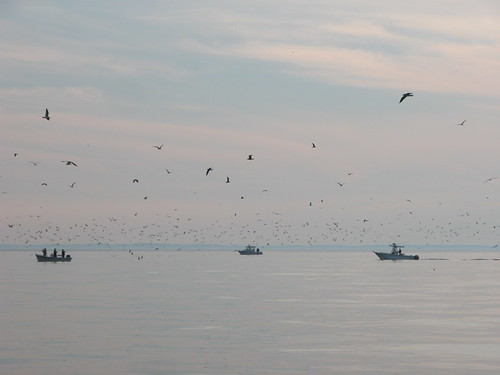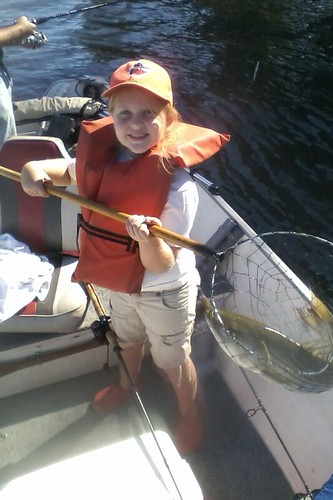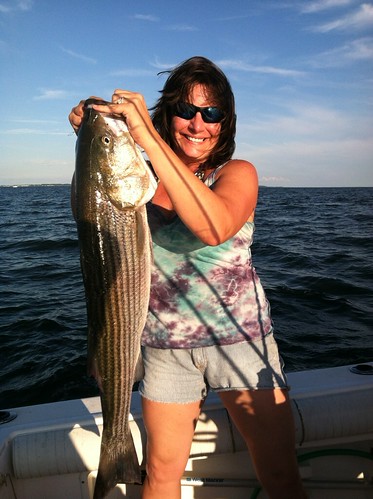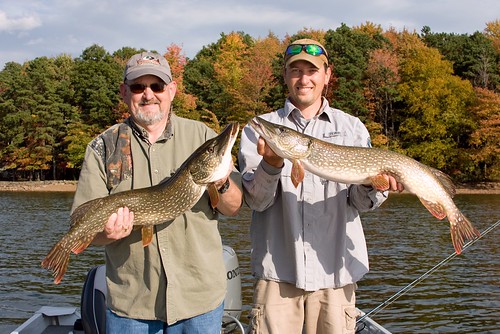By: Keith Lockwood
As each day rolls by, most of us start to notice things are changing such as a scarcity of daylight in the mornings when we get up to head off to work or that we can't quite get as much done in the yard before dark when we get home from work. The season is changing as evidenced by color starting to show in trees, the arrival of geese and certainly the cooler temperatures; all in line with the rhythm of the seasons and our entry into October. This is indeed a very special month for the outdoors in Maryland so please make some preparations to enjoy it to its fullest. Activities such as taking children for a hike in the fall woods, canoeing down a secluded waterway to bath in the colors and sounds of fall or getting out and doing some fishing, there are countless things to enjoy in the outdoors of Maryland. The fall trout stocking program is underway and stocked trout and kids just naturally go together. Striped bass are schooling up in the Chesapeake as they chase schools of baitfish providing for some of the finest light tackle fishing to be experienced anywhere. Diving sea gulls, breaking striped bass and anxious fishermen paint a wonderful fall picture on the Chesapeake.

Photo by Keith Lockwood
At the head of the bay the topwater fishing for striped bass remains good this week and the action is now extending longer into the late morning hours and commencing earlier in the evenings. Shorter daylight hours and cooler water temperatures are causing the grass on the Susquehanna Flats to begin to break up making it difficult at times to keep lures and lines from fouling. There are fewer water releases at the Conowingo Dam lately and some days there are no releases so there can be good fishing opportunities at the dam pool in the late afternoon hours as well as the mornings.
A little farther down the bay there are some larger striped bass being caught by drifting live eels around Pooles Island and the mouth of Baltimore Harbor where there are good current flows. Casting topwater lures in these same areas or near structure is also a good tactic as is jigging with soft plastics. White perch are very much part of the mix in these areas so jigs tipped with a piece of bloodworm or bottom rigs baited with the same are a good bet.
The channel edges near Swan and Love Points has been a good place to troll spoons, bucktails and surge tube lures for a mix of bluefish and striped bass. Planers and heavy inline weights are being used to get spoons and surge tubes down to where the fish are holding. Other areas worth checking out include the channel edges near Sandy Point Light, the Sewer Pipe and Dumping Grounds near the Bay Bridge. The Bay Bridge piers continue to be a good place to also look for striped bass; live lining spot or eels and jigging are all good methods to fish the piers. The lower sections of the Magothy and Chester River are also good places to check, since striped bass have been moving into the tidal rivers to chase schools of bait. The water temperatures in the tidal rivers are in the mid 60's now and bait is beginning to move down the rivers and heading for the bay. Trolling or casting jigs in the deeper waters is a good tactic as is casting topwater lures in the shallower waters in the mornings and evenings. Amelia Sohns got to do some light tackle casting in the Magothy River with her dad recently and proudly holds up her first striped bass.

Photo courtesy of Amelia Sohns
There is plenty of action in the middle bay region this week; water temperatures are dipping to the 70ºF mark and it is even lower in the tidal rivers. A mix of bluefish and striped bass are chasing schools of bay anchovies and small menhaden in the tidal rivers and bay. Trolling spoons, bucktails and surge tube lures are a very popular and productive method to fish and channel edges are one of the better places to troll. More and more schools of feeding fish are being encountered, either on the surface or suspended. Diving birds are always a good sign, but slicks are also a valuable clue to look for. The edges of the shipping channel, the mouth of Eastern Bay and all of the tidal rivers in the region are excellent places to look for a mix of bluefish and striped bass.
Light tackle jigging and casting to breaking fish is coming into its own this week as the striped bass start exhibiting a typical fall pattern of behavior. Metal jigs are a favorite now because of the presence of bluefish but once they move out soft plastic jigs will become more popular. The shallow water fishing for striped bass has been good in many areas with good current flow and structure. Topwater lures are always a favorite for this type of fishing to reduce grass fouling and the excitement of surface strikes; a high flood or high ebb tide often offers the best fishing opportunities. Fishing for white perch in these same areas has been good recently and ¼ oz spinners cast near shoreline structure with ultra-light tackle is a fun way to catch them. Beetle spin type lures and small jigs tipped with a piece of bloodworm are also very effective. A simple one hook bottom rig or jig head baited with grass shrimp of bloodworm worked around dock piers is also a good tactic.
There are still some spot in the lower sections of most of the regions tidal rivers and many of them are fairly large. Those who still wish to live line spot are finding a few in the shallower areas of the tidal rivers. There are also a few croaker still around and white perch can also be part of the bottom fishing mix. Becky Goudy and her husband managed to find a few spot in the Herring Bay area and gave them a try just south of Poplar Island and Becky was rewarded with this nice striped bass.

Photo courtesy of Becky Goudy
The lower bay region tends to be holding a lot of bluefish this week and also the largest specimens to be found in Maryland waters. Some of the bluefish being caught are 5 lbs or better. Trolling a mix of spoons and surge tube lures behind planers and inline weights has been a very popular way to catch a mess of bluefish. The edges of the shipping channel and channel edges in the lower Potomac as well as Tangier Sound and the Middle Grounds are all excellent places to troll. There are striped bass to be caught in the region but a fair percentage are coming up short of the 18" minimum out in the bay. A larger grade of striped bass are being caught in the shallows and channel edges in the region's tidal rivers such as the Patuxent and Potomac Rivers on topwater lures and jigs.
The large spot and croaker continue to be holding at the mouth of the Patuxent River and the Tangier/Pocomoke Sound area this week as they start to think about heading south. The spot are nice large bronze backed specimens and it is not uncommon to be able to fill up an ice chest with them in short order. Bloodworms on a bottom rig are the best option for catching them. Flounder are also being caught near Point Lookout Rip, Cornfield Harbor and the shoal edges near channel areas in Tangier and Pocomoke Sounds.
Freshwater fishing in the western region continues to improve on all fronts as cooling water temperatures in lakes, reservoirs and streams have fish switching to a more active mode. Fishing at Deep Creek Lake is improving for some of the coldwater species such as smallmouth bass, walleye and northern pike. Fisheries biologists have recently been tagging northern pike in Deep Creek Lake to better understand their population dynamics. The pike are being caught by casting large spinners and plugs in the grassy coves, tagged and released. Matt Sell and Allen Ellis hold up a pair of nice Deep Creek Lake northern pike for a picture before releasing them back into the lake.

Photo by Tom O'Connell
The upper Potomac River is reported to be running very low and clear and that the grass there is starting to break up and causing lines and lures to foul with broken stems of grass. Smallmouth bass are being caught on small crankbaits and swim shad type jigs near current breaks, underwater ledges and large submerged boulders.
The fall trout stocking program is underway and trout anglers are enjoying plenty of action in the put and take trout management areas. One can check the trout fishing website to find which waters are scheduled to be stocked and can also receive confirmation of stocking via the Fisheries email service.
Stream and river flows are down in most of the western and central regions but cooler water temperatures are assuring that the trout being stocked will remain healthy and active for trout fishermen. Trout fishing in the fall usually means plenty of elbow room for trout fishermen and with the fall colors beginning to emerge it is a wonderful time to get out and enjoy some excellent trout fishing. Ethan Fike got to do some trout fishing recently and holds up a nice stringer of rainbow trout he caught.

Photo courtesy of Ethan Fike
Largemouth bass fishing in Maryland's many ponds, lakes, reservoirs and tidal rivers is beginning to move towards a fall pattern of activity. Largemouth bass can be found along the outside edges of grass, lily pad and spatterdock fields. Spinnerbaits and small crankbaits are a good choice along these edges and soft plastics when actually casting into the grass. Sunken wood such as fallen treetops and brush are good places to target with jigs and crankbaits as well as bridge and dock piers. Grass beds are beginning to break up in the tidal rivers and can cause some difficulty with fouled lines and lures.
Fishing for a mix of channel catfish and flathead catfish has been good in the lower Susquehanna River and fishing for blue catfish in the tidal Potomac has been excellent. Channel catfish can be found in most tidal rivers flowing into the Chesapeake and cooler water temperatures have them actively feeding. Most any kind of fresh cut bait, nightcrawlers or chicken liver are good choices for baits on a simple bottom rig.
Ocean City area fishing is undergoing some noticeable changes this week. Water temperatures are declining and flounder are starting to move out of the back bay areas and head for the Ocean City Inlet. The next week or so will most likely offer some of the best flounder fishing opportunities in the channels leading to the inlet. Surf fishing is focusing mostly around catching small bluefish on finger mullet rigs, a few short striped bass and some catch and release fishing for red drum. At the inlet there is good fishing for a mix of sheepshead and tautog around the rocks and bulkheads. Sand fleas and pieces of green crab are the baits being used. Jeff Kellner holds up a really nice sheepshead he caught at the inlet recently.

Photo courtesy of Jeff Kellner
The boats heading out to the wreck and reef sites continue to bring excellent catches of flounder back to the docks. Sea bass are still off limits until October 18th so besides flounder, triggerfish, blowfish and the occasional tautog are rounding out the mix for fishing on party boats.
The boats heading out to the canyons are catching a lot of dolphin and a large portion of them are gaffers. They are being found along weed lines and when anglers are able to keep them behind the boat; the spinning gear comes out and small jigs with bait strips can fill up a fish box quickly. Some long fin albacore have been caught as well as a few bigeye tuna at Poormans and Washington Canyons and there are white marlin being caught and released at the Norfolk Canyon.
Boom...Morgan
No comments:
Post a Comment